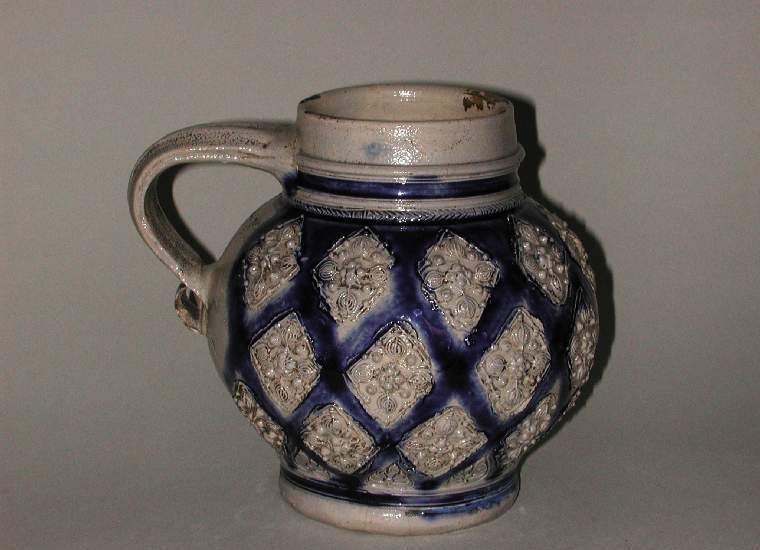Current Location: In storage
Maker(s)
Production:
Unidentified Westerwald pottery
Entities
Categories
Description
Grey salt-glazed stoneware decorated with applied moulded lozenge-shaped reliefs reserved in a blue ground
Grey stoneware, thrown and turned, with applied handle, the sides decorated with applied moulded reliefs reserved in blue painted ground, and salt-glazed. The globular body stands on a low solid base encircled by turned bands. The base of the short cylindrical neck is encircled by a band of herringbone pattern, above which are turned bands and a more pronounced cordon level with the top of the strap handle, which has a longitudinal ridge and an upward folded kick at its lower end. It has a small hole at the top to take a mount for a cover. The sides are decorated overall (apart from an area beside and under the handle) with three staggered rows of lozenge-shaped reliefs (9, 8 and 9) each containing a central stylized flowerhead surrounded by four fruits or leaves, with four beads in the spaces. Below these, is a row of impressed pointed leaves. The background is blue, and there is a broad blue band round the foot and round the neck.
Notes
History note: Thomas Sutton, Eastbourne, from whom bought in March 1905, for £1.10s.9d (30s.) by Dr J.W.L. Glaisher, FRS, Trinity College, Cambridge
Legal notes
Dr J. W. L. Glaisher Bequest
Measurements and weight
Height: 15.5 cm
Width: 17.6 cm
Acquisition and important dates
Method of acquisition: Bequeathed
(1928-12-07)
by
Glaisher, J. W. L., Dr
Dating
17th Century, Late-18th Century, Early
Circa
1680
-
1720
Note
The stoneware industry in the Westerwald developed first in the area of three villages, Höhr, Grenzau and Grenzhusen (currently Höhr-Grenzhausen), where potters formed a guild in 1643, and expanded to other villages in the area. Production increased greatly after the end of the Thirty Years War in 1648 and Westerwald stoneware was exported on a large scale to other European countries, including Britain. This jug illustrates the typical decoration of applied moulded reliefs which was popular in the late 17th and early 18th century. A huge range of different plant and geometrical motifs were employed, which look very striking against a blue ground, and were often decorated in blue and manganese-purple (a dark reddish purple). When new, the jug probably had a pewter mount attached to the top of the handle, hinged to a thumbpiece and cover.
School or Style
Baroque
Components of the work
Background
composed of
smalt
( produced by fusing cobalt with an alkali, usually potash, and sand, grinding to a powder and mixing with water)
Surface
composed of
salt-glaze
Base
Diameter 9 cm
Body
Decoration
Materials used in production
grey
Stoneware
References and bibliographic entries
Identification numbers
Accession number: C.2048-1928
Primary reference Number: 73048
Old object number: 2285
Stable URI
Audit data
Created: Saturday 6 August 2011
Updated: Tuesday 30 April 2024
Last processed: Tuesday 15 July 2025
Associated departments & institutions
Owner or interested party:
The Fitzwilliam Museum
Associated department:
Applied Arts






